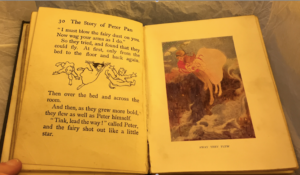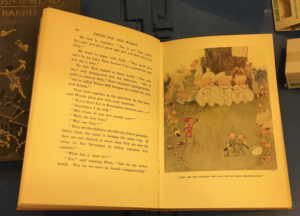Picture This
What’s the relationship between text and image in illustrated children’s books? In this blog, Niamh reflects on this question, thrown up by having to choose between a multitude of beautiful different editions of the same text for our ‘Growing Up With Books’ exhibition.
*
As you know, the SELCIE group has been deciding which books will end up in the exhibition and the catalogue next year. I have no need to tell you how hard it is to making such choices. However, during this time, I have come across a difficulty that I had not really thought about until now: how to evaluate volumes that contain the same text but have differing illustrations.

Dr Sarah Dunnigan and I are putting together the “other world” cabinet, a box that will showcase magic, fairies and various other enchantments; we decided that, for this, the Scottish author J. M. Barrie’s Peter Pan would grace us with its esteemed presence. However, in our numerous boxes, there are countless versions of the text. This got me wondering how far does illustration work in conjunction with the text of a book.
Some writers are particularly demanding in what they want the pictures in their books to demonstrate, as was the case of author Lewis Carroll and cartoonist-cum-illustrator John Tenniel: ‘The charts [Carroll] drew up for the sequence of llustrations [sic] include not only meticulous numberings, endlessly scratched out, redrafted and revised. … He wrote copiously to Tenniel to monitor his progress and control his interpretations’ (Warner). So many questions spring from these actions. To list a few: (i) How far do illustrations work independently of the text? (ii) What happens after the work no longer must be printed with these illustrations? (iii) How much power does the illustrator have over the narrative of the story? (iv) If the author has demanded a set of drawings be commissioned for his or her text, then does it become a different piece of work if other illustrations are used? I think these are very important issues, which demand close consideration but that does not mean I have any settled opinions on the matter.
If one were to argue that such things are unimportant then he or she would do well to consider the situation as applied to picture books or comic books: two components that work less with the written word and more with the illustrations. As one who is currently researching postcolonial paraliterature, including Hugo Pratt’s ‘Corto Maltese’ series, I would say that a lot of information is implicit in what appears in the frame, as opposed to what is explicitly declared in speech bubbles. Indeed, within a comic strip, ideas can subtly be diffused to and absorbed by the reader/viewer, in just as many ways as the written words of a text can be transmitted.

In choosing which Peter Pan text to exhibit, this idea of the importance of illustrations and their differing values and meanings has really come into focus for me. With that in mind, which volume of Barrie’s text should be chosen to show the general public? I am hoping that we can exhibit as many as possible, in part to manifest these ideas but, additionally, to give a showcase to as many different artists’ ideas as space allows.
References
Warner, Marina. ‘Curiouser and curiouser.’ Tate Etc. 1 Sept. 2011 <http://www.tate.org.uk/context-comment/articles/curiouser-and-curiouser> Web.


